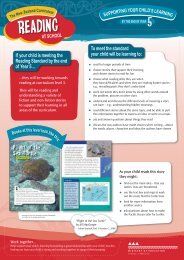Sabbatical Report - Oranga School Website
Sabbatical Report - Oranga School Website
Sabbatical Report - Oranga School Website
You also want an ePaper? Increase the reach of your titles
YUMPU automatically turns print PDFs into web optimized ePapers that Google loves.
<strong>Sabbatical</strong> <strong>Report</strong> 2009<br />
would like to write. Following this the C-SPACE mnemonic was taught<br />
(C=Character, S=Setting, P=Problem or purpose for story, A=Action,<br />
C=Conclusion and E=Emotion). The reviewing strategy taught participants<br />
how expert writers reread, review, edit and revise their texts with emphasis<br />
being placed on making meaningful changes and spelling and mechanical<br />
fixes were mentioned as editing. Teaching occurred at the beginning of each<br />
session and a written reviewing prompt was given at the end of each initial<br />
writing session (Albertson & Billingsley, 1997). The study was carried out with<br />
two highly capable 12-year-old, sixth-grade students.<br />
Graham et al. (1998) in their study looked at the use of the SRSD model<br />
through two case studies (i.e., Case 1: 6 mainstreamed fifth and sixth-grade<br />
learning disabled students; Case 2: 3 individually taught fifth-grade learning<br />
disabled students) where the practice was defined as the explicit teaching of<br />
planning and revising strategies.<br />
The Graham et al. (1998) study was operationalised through the explicit<br />
teaching of mnemonics (i.e., TREE 2 and STOP & LIST 3 ). The mnemonics<br />
were taught using the SRSD model of teaching a strategy and this<br />
involves six instructional stages which include developing background<br />
knowledge, discussing, modelling, memorising, support and<br />
independent performance. SRSD is characterised by interactive<br />
learning, targeted instruction to the individual child, criterion based<br />
instruction and a developmental process.<br />
A further study into the explicit teaching of writing strategies by De La Paz and<br />
Graham (2002) defined the practice of explicit strategy instruction as<br />
“teaching students strategies for planning, drafting, and revising text, the<br />
knowledge and skills needed to support these processes were also<br />
emphasised” (De La Paz & Graham, 2002). The 2002 study extended the<br />
work of Graham et al. (1998) by taking the teaching to non learning disabled<br />
students, the students’ own teachers doing the teaching and larger class<br />
sizes. This was unlike the previous study that had focussed on learning<br />
disabled students and either one on one or small group teaching. De La Paz<br />
et al. (2002) operationalised the study through the use of a mnemonic as the<br />
key element of the strategy. This was similar to that of the 1998 study. The<br />
mnemonic organised and directed the processes for planning and writing an<br />
essay. This strategy also prompted the students to use their plan while writing.<br />
As with Albertson et al. (1997) the plan provides an external memory where<br />
novice writers can store ideas without losing them and may further reduce the<br />
need to plan while writing, freeing up resources to engage in other writing<br />
processes (e.g. translating ideas into words, transcribing words into text<br />
reviewing, revising).<br />
2 THINK, PLAN, WRITE: Think who will read this, and why I am writing it? Plan what to say using<br />
TREE: Topic sentence, Reasons, Examine, Ending. Write and say more.<br />
3 STOP & LIST: Stop Think Of Purpose & List Ideas Sequence Them<br />
Jonathan Ramsay<br />
<strong>Oranga</strong> Primary - One Tree Hill - Auckland




